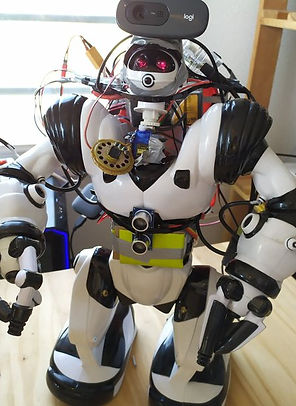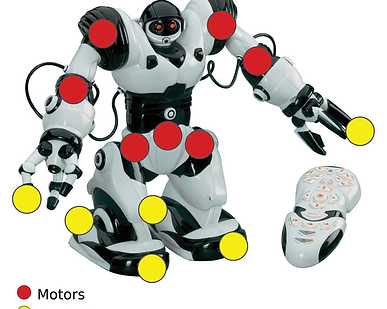

A little backstory- what even is a RoboSapien?
Surprisingly, this information is actually very significant. Many people may know what a RoboSapein is, but very few know of the extensive lore- and how this project fulfills the robot's long awaited destiny.



Mark Tilden
master of motion
The inventor of RoboSapien is no ordinary man- he is THE Mark Tilden, former biomechanics engineer at the NASA Los Alamos laboratory. He made a variety of basic stimulus driven robots that ran without code. He called the right angled logic circuits that you would find inside of computers "Manhattan logic". He stated that the binary logic driven nature of these machines meant that true emergent behavior was impossible, while later disproven, he was onto something. He made robots that didn't need any kind of programming, they were entirely stimulus driven. He loved simplicity in functionality. Basically, his robots had "Hexagonal" circuits when viewed from underneath a microscope that operated like what we call a neural network today. Simple stimulus would excite a specific pathway in the robot's silicon, essentially making the robot a very basic living thing. He made sand dune robots that would scuttle across sand to follow light and navigate. He also made many more robots, but we recommend you click here to see an interview article of Mark Tilden detailing his work in this field.



Mark Tilden and his Humanoid Marvels
RoboSapipen V1 as well as RoboSapipen V2 had some design queues form real astronautic robots. Tilden had previously contributed to a project known as the "robonaut1" and later "robonaut2", A humanoid robot designed to do things on the ISS that humans would be in danger doing, or just didn't want to do. The robots showed huge strides in engineering, but had unfortunately been decommissioned in 2018, solidifying his grip in the robotics industry, but strangely enough, this is not what he is widely known for. This shows his knowledge of the biomechanics fields, and how he applies this to his robots. RoboSapien is much more than meets the eye from an engineering standpoint- he's a masterpiece of overqualified engineering.

Mark Accidentally Makes The Hottest Toy of 2004
In 2001-2002, Mark Tilden had designed a walking robot for basic household tasks, such as opening beers in his home in SantaFe, New Mexico. The robot was initially nothing more than a tinker toy- something that he made in his spare time, but he had eventually finished the robot and brought it to some toy manufacturers to see what they thought of the robot. Two companies, Sharper Image and Wowee Robotics found interest in the project. It is unknown how much the companies paid Mark Tilden, but in holiday of 2004, Robosapien was finished up and the bottle opener was removed for the more family friendly three fingered pincher. He was also re-skinned several times to look more toy-like and went through many design changes until we got the swollen astronaut look we know today.
In holiday of 2004 alone, Robosapien sold 1 million units. The total estimated units sold today are 12 million, including the later RoboSapien x. On this earth, there are more RoboSapiens than:
-
Tesla Roadsters
-
Segues
-
GameBoy Micros
-
ipod Minis
-
PS Vitas (Maybe)
-
Microsoft Zunes
Long story short, in the blink of an eye, millions were made. This robot is very easy to find now in a variety of styles and conditions, and for cheap too. (Currently about 50 bucks on Ebay in good shape.)
-
Sega Dreamcasts
-
NeoGeos
-
1st Gen Apple Home Pods
-
Original Pebble Watches
-
Nintendo WiiUs (Maybe)
-
Sony Betamaxes
- Panasonic 3D0s
-
Laser Disc Players
-
Nokia N-Gages
-
1st Gen Sony Power Shots
-
PALM Pilots
-
TOSHIBA HDDVD Players
- Sony MAVICAs
-
Apple Newtons
-
Atari 5200s
-
Xbox 360 Xenons (still working)
-
Original Xboxes (still working)
-
Sony Mini Disc Players

Below are images images of prototypes.








Once a tinker toy, always a tinker toy.
RoboSapien was made to be more than just a toy. Mark Tilden has openly spoken about how the robot was made for modification after purchase. Mark had the robot doing a variety of tasks that were not viable for effective mass production. Mark's initial versions could free roam, interact with the world using more sensors, and was easier to modify on the fly for specific tasks. Somewhere along the line, turning the robot into a toy saw the loss of a lot of functions, especially due to limited processing power. The retail version is using a PIC16F84 8-Bit micro controller that could only address 6 of the 7 motors at once. It ran on only 1 kilobyte of RAM and a 14 bit wide execution bus, all at 20 MHz. With these specs, its no wonder he sounds so robotic. The toy version of the product was so simple- it could literally just remember a few movements and sounds as well as receive commands from an infrared remote. The robot was so constrained that it was impossible to get the machine to walk into walls and turn around creating a very simple kind of free roaming, no matter how much kids may have wanted that. Free roam mode became somewhat of an internet meme, or troll. Mark had made a number of design choices that would make it very easy for anyone to modify the robot. The robot uses only off the shelf DC motors and simple mechanical switches as encoders, as well as springs to act like muscles and tons of extra space was left inside of the robot (specifically in the abdomen) to accommodate for vastly superior computers. People have taken note of this and modified the robot by replacing the micro controller, hijacking the IR interface or using an IR base station. More often than not, these designs are clunky and inefficient, Producing hard to program behaiviour or limited control of the body. Books like "The Robosapien companion" were written to document how to do basically whatever you want with the robot, but here's where we stepped in.
